Picture this: It’s a sunny Saturday morning, and you’re scrolling through real estate listings with a cup of coffee in hand. Maybe you’re an investor eyeing your next big move, a first-time buyer hoping for a miracle, or a real estate agent prepping for your next open house. No matter which hat you wear, one thing is clear—2025’s real estate market is anything but predictable. The headlines are dizzying: record-high home values, affordability at historic lows, and migration patterns that look like someone shook up the snow globe of American demographics.
If you’ve ever wondered whether the “location, location, location” mantra still holds up—or if you’re just trying to figure out whether to rent or buy before your next lease is up—this deep dive into the latest real estate statistics is for you. I’ve combed through the freshest data from , , , and more to bring you the numbers that matter most in 2025—plus the stories behind them. Let’s break down what’s really happening in the market and what it means for you, whether you’re buying, selling, investing, or just watching from the sidelines.
2025 Real Estate Statistics at a Glance: The Top 10 Numbers
Let’s start with the heavy hitters—the stats that are shaping every conversation in real estate this year. These are the numbers you’ll want to drop at your next dinner party (or, you know, your next client meeting).
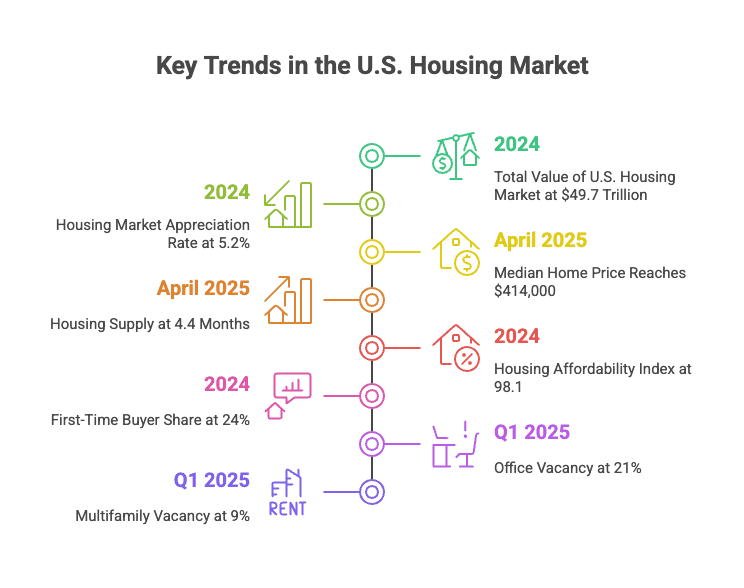
- $49.7 Trillion — Total Value of U.S. Housing Market (2024): The combined value of U.S. homes hit a record , up 5.2% year-over-year. That’s more than double the value from a decade ago.
- +5.2% — Housing Market Appreciation Rate (2024): Home values grew , a sharp drop from the 18% surge in 2021, but still positive.
- $414,000 — Median Home Price (April 2025): The reached an all-time high in April 2025, up 1.8% year-over-year.
- 4.4 Months — Housing Supply (April 2025): to a 4.4-month supply, the highest in two years, but still below the 6-month “balanced market” threshold.
- 98.1 — Housing Affordability Index (2024): The averaged 98 (100 means a median-income family can just afford the median home), making 2024 one of the toughest years for buyers in decades.
- 24% — First-Time Buyer Share (Record Low): Only , the lowest on record.
- +17.9% — Fastest Home Price Growth (Syracuse, NY): with nearly 18% year-over-year price growth.
- –2.9% — Biggest Home Value Decline (Cape Coral, FL): Some markets cooled, with .
- 21% vs 9% — Office vs Multifamily Vacancy (Q1 2025): , while multifamily rentals stayed tight at 9%.
- 191% vs 2% — Rent vs Buy Cost Gap: In San Francisco, buying costs ; in Detroit, it’s only 2% more.
Each of these numbers is a window into the market’s soul—revealing where the opportunities, risks, and surprises live in 2025.
Global Real Estate Statistics: How the World Market Is Shifting
While the U.S. gets a lot of the spotlight, the global real estate market is also in the midst of a transformation. The total value of global real estate is estimated in the hundreds of trillions, with the U.S. making up a significant chunk thanks to its nearly $50 trillion housing market. But what’s really interesting is how different regions are moving at different speeds.
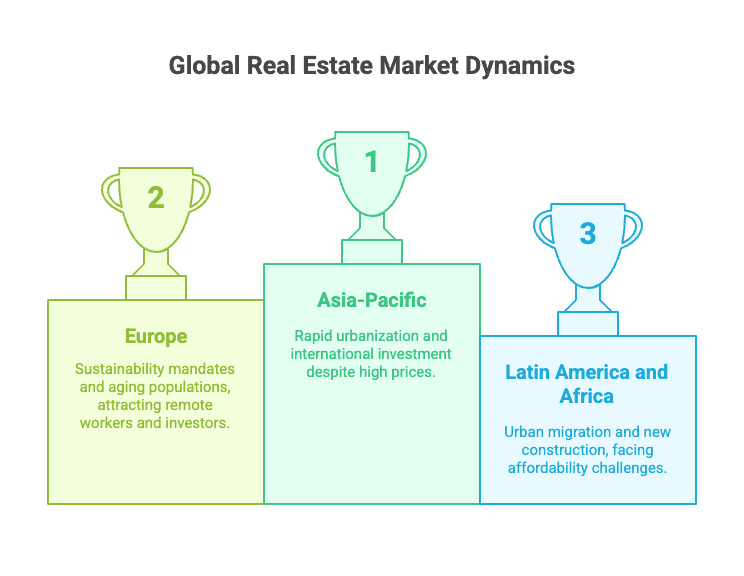
- Asia-Pacific continues to see rapid urbanization, with cities like Singapore and Sydney drawing international investment despite high prices.
- Europe is grappling with sustainability mandates and aging populations, but cities like Berlin and Lisbon are attracting remote workers and investors.
- Latin America and Africa are seeing urban migration and new construction, but affordability remains a challenge.
International investment flows have shifted, too. Foreign buyers in the U.S. purchased in the past year—a 15-year low, as high prices and a strong dollar made U.S. real estate less accessible. Canada remains the top foreign buyer, especially in Florida and Arizona vacation markets ().
The big global trends? Urbanization, migration for affordability, and a growing demand for sustainable, energy-efficient buildings. If you’re investing internationally, keep an eye on which cities are attracting talent and capital—and which are losing out to more affordable, livable alternatives.
U.S. Real Estate Market Value: Growth, Hotspots, and Projections
Let’s zoom in on the U.S., where the numbers are both eye-popping and nuanced.
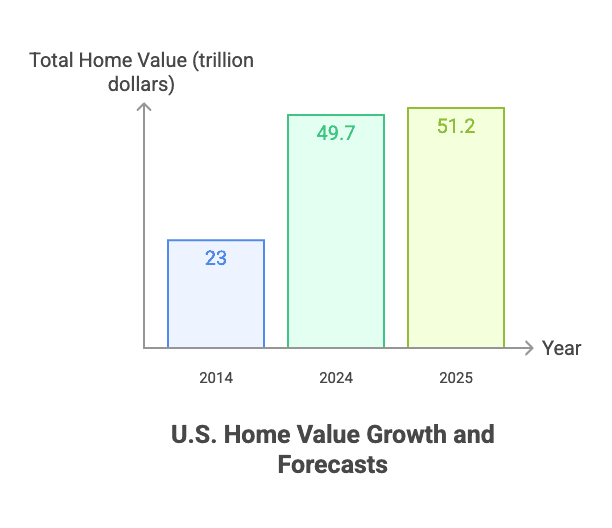
- The , up from $23 trillion in 2014. That’s more than doubling in a decade.
- Growth is slowing, though. The 5.2% appreciation in 2024 is the slowest since 2019, as higher interest rates and affordability issues cool the market.
- that the market will remain “largely frozen” through 2025, with home prices rising about 3% or less per year.
Where’s the Action?
- Northeast and Midwest: Cities like Syracuse, NY (+17.9%), Montgomery, AL (+16.1%), and Youngstown, OH (+13.6%) are leading the nation in price growth ().
- Sunbelt and West: Markets like Austin, Phoenix, and Cape Coral, FL have cooled, with some even seeing price declines.
- Coastal Metros: Still the most expensive, with San Jose’s median home price at $2.02 million ().
The story? The U.S. market is a patchwork quilt—some squares are hot, others are cooling, and the overall pattern is more balanced than in the pandemic frenzy.
Housing Prices in 2025: Where Are They Rising and Falling?
The national hit $414,000 in April 2025, a record for that month. But the real action is in the regional details:
| Region | Median Price (Apr 2025) | YoY Change |
|---|---|---|
| Northeast | $487,400 | +6.3% |
| Midwest | $313,300 | +3.6% |
| South | $365,300 | –0.1% |
| West | $628,500 | –0.2% |
- Northeast & Midwest: Leading in price gains, thanks to affordability and low inventory.
- South & West: Flat or slightly down, as affordability bites and new construction adds supply.
Top 10 Fastest-Rising Markets (Q1 2025):
- 6 of the top 10 are in New York or Ohio, with ).
Biggest Declines:
- , with other Florida and Mountain West cities seeing small dips.
The takeaway? Local supply-demand imbalances are driving wild swings—so don’t assume your market is moving like the national average.
Housing Affordability and Inventory: Can Buyers Keep Up?
This is where the rubber meets the road for most Americans.
- Inventory: , up 20.8% from a year ago. That’s a 4.4-month supply—still tight, but better than the record lows of 2021–2022.
- Days on Market: Homes now sit for , up from 26 days last year.
- Affordability Index: Averaged —the second-worst for buyers in decades. It’s ticked up slightly in 2025, but still tough out there.
- Monthly Payments: A typical home now comes with a (20% down), eating up about 25% of median family income.
- First-Time Buyers: Only were by first-timers, the lowest share ever.
Affordability is especially brutal for first-time buyers, who often put less down and face higher monthly costs— on average.
Real Estate Investment Statistics: Where the Smart Money Is Going
If you’re an investor, 2025 is all about being selective and watching the trends.
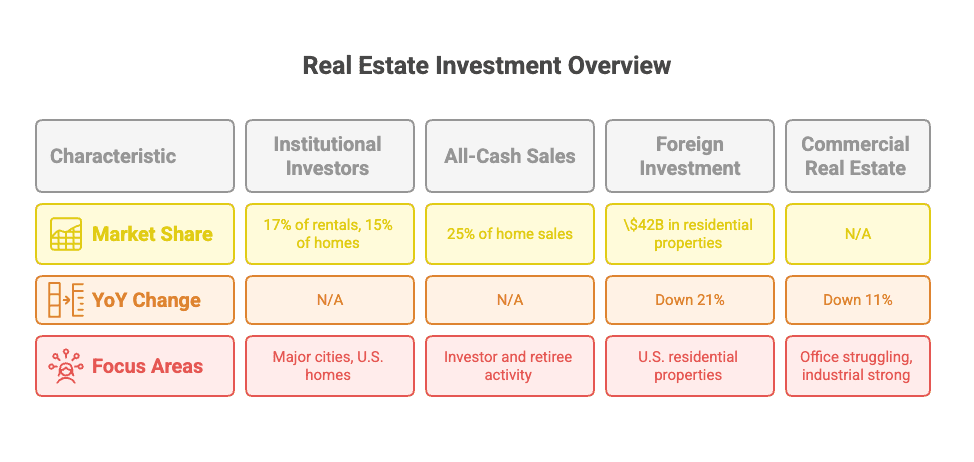
- Institutional Investors: Now own . Investors (individual + institutional) bought about .
- All-Cash Sales: in April 2025 were all-cash, reflecting both investor and retiree activity.
- Foreign Investment: bought by international buyers (down 21% YoY).
- Commercial Real Estate: Foreign capital in U.S. commercial real estate fell 11% YoY in 2023 (), with office properties struggling and industrial/logistics remaining strong.
Emerging Opportunities:
- Build-to-rent single-family homes
- Proptech (property technology) startups—over )
- Green and sustainability-focused investments (22% of new commercial developments are green-certified)
Renting vs. Buying in 2025: Which Is More Cost-Effective?
The rent vs. buy debate is more local than ever—and the numbers might surprise you.
- In San Francisco, buying a median home costs .
- In Detroit, the gap is just .
- saw the rent-vs-buy gap widen last year.
- The “breakeven horizon”—how long you need to own before buying pays off—is typically .
In short: Renting is often cheaper in high-cost cities, but buying can make sense in the Midwest and South—if you can afford the down payment.
Migration and Demographic Trends Shaping the Housing Market
People are on the move, and it’s reshaping the real estate map.
- Texas led the nation with in 2024.
- Florida added , mostly from international migration and retirees.
- North and South Carolina are booming, with respectively.
- Urban to Suburban Shift: Suburbs and small metros are growing faster than city cores, as remote work sticks around.
- Generational Moves: Baby Boomers now make up , while Millennials and Gen Z are being priced out or moving to more affordable regions.
Migration is fueling growth in affordable markets and cooling demand in pricey coastal cities.
Real Estate Trends to Watch: Technology, Sustainability, and Design
I love seeing how technology and lifestyle trends are shaking up real estate—sometimes in ways that make me wish my own house had a few more “smart” features (and maybe a robot that does laundry, but I digress).
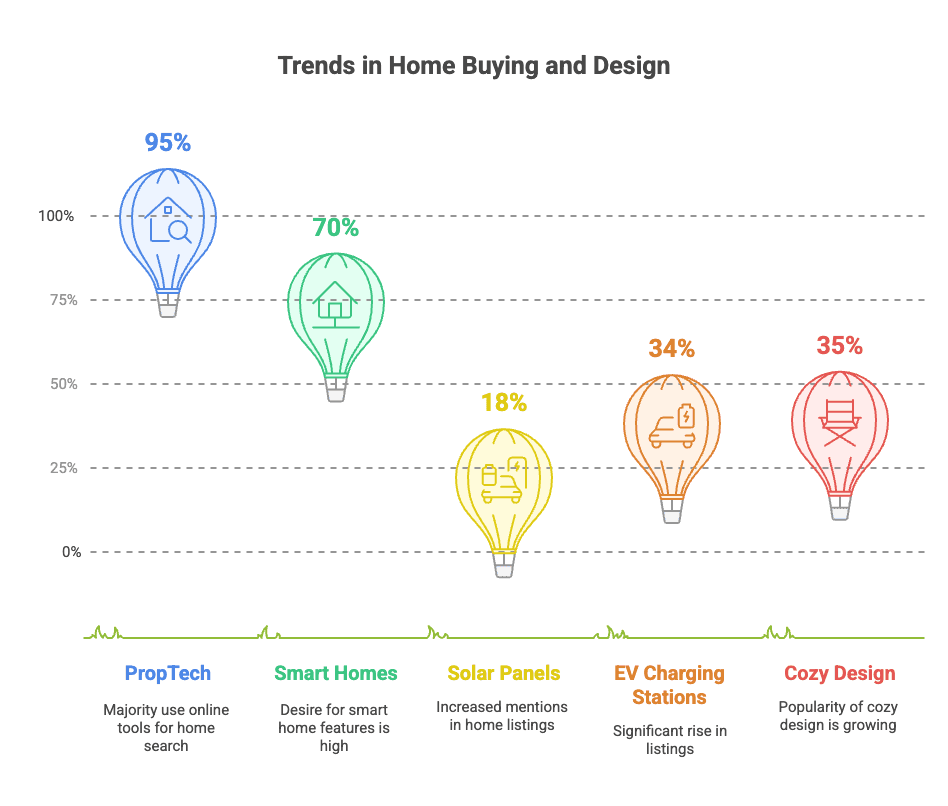
- PropTech: Over to search for homes. Virtual tours, e-closings, and AI-powered pricing are now the norm.
- Smart Homes: —think thermostats, security, or voice-controlled lights.
- Sustainability: in 2024. . Green features can add up to 4% to home value.
- Design: “Cozy” is in—. Nostalgic and vintage styles are making a comeback, and multi-generational living is influencing new floorplans.
On the commercial side, smart building systems, touchless entry, and conversions of office space to residential or lab use are big trends. In 2025, more office space may be converted than newly built—a sign of the times ().
Regional Real Estate Statistics: Buyer’s vs. Seller’s Markets
So, is it a buyer’s or seller’s market? The answer is: it depends (don’t you love that?).
- Buyer’s Markets: Mountain West, Southwest, and parts of the South—think Austin, Phoenix, Las Vegas, and mid-sized Florida cities. Inventory is up, price growth has stalled, and buyers have more negotiating power.
- Seller’s Markets: Northeast metros (Albany, Manchester), parts of the Midwest (Indianapolis, Cincinnati), and the entry-level segment nationwide. Severe supply shortages mean sellers still call the shots.
- Nationally: We’re in a “mild seller’s market,” with a , but the balance is shifting.
Metrics to Watch:
- Sale-to-list price ratio is down to 98–99% (from 102% in 2022).
- About 1 in 5 listings had a price cut in 2024.
The bottom line? All real estate is local. In 2025, you might find a buyer’s market for condos downtown, but a seller’s market for single-family homes in the suburbs.
Key Takeaways: What 2025 Real Estate Statistics Mean for You
Here’s my quick-hit advice, based on all this data:
For Investors: Be selective. Rental housing and industrial properties are strong bets, but office and some retail are risky. Cap rates are rising, so new acquisitions may offer better yields. Watch for distressed deals and be ready to reposition assets.
For Buyers: Patience is finally paying off. There’s more inventory and less competition, but affordability is still tight. Focus on what you can afford, negotiate for concessions, and don’t expect a price crash. If you plan to stay put for 5+ years, buying can still make sense.
For Real Estate Pros: Embrace tech, know your local data inside and out, and set realistic expectations for clients. Highlight trending features (energy efficiency, home offices), and be ready to help clients navigate a more balanced, nuanced market.
And if you’re just watching from the sidelines, remember: the market is always changing, and the best decisions are the ones grounded in real, up-to-date data.
Methodology and Sources: How We Compiled These Real Estate Statistics
I built this report using the latest (2024–2025) data from the most reputable sources in real estate, including:
- for sales, prices, inventory, and affordability
- for home value trends and buyer preferences
- for market value and inventory
- and for affordability and rent-vs-buy comparisons
- for forecasts
- for demographic and migration data
All stats are cited inline for easy reference and maximum credibility. If you want to dig deeper, check out the links throughout this post.
Whether you’re buying, selling, investing, or just trying to keep up with the wild ride that is the 2025 real estate market, one thing’s clear: data is your best friend. And if you’re looking for a way to gather, organize, and analyze real estate data (or any web data, really), check out . Our makes it easy to pull the latest listings, prices, and trends into your favorite spreadsheet or database—so you can make smarter, faster decisions.
If you enjoyed this deep dive, you might also like some of our other guides on the , like or .
Here’s to making 2025 your smartest year in real estate yet. And remember: when in doubt, follow the data—because the market never lies (even if it sometimes tells dad jokes).